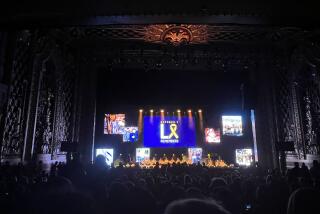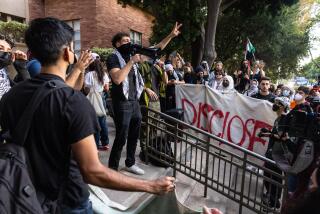70 Years After WWI Holocaust : Armenians Celebrate Heritage, Survival
Harry Chitjian, an 85-year-old survivor of the Armenian holocaust, wished that his father could have seen the “glory” as he watched hundreds of his people celebrate their culture and heritage on Sunday afternoon at a Hollywood park.
“He wants his father to know that they didn’t perish,” said Chitjian’s daughter, Zaruhy. “He would like his father to know that he is free and alive in the United States.”
For the record:
12:00 a.m. Oct. 26, 1986 For the Record Armenian Group Does Not Endorse Terrorism
Los Angeles Times Sunday October 26, 1986 Home Edition Part 1 Page 2 Column 1 Metro Desk 1 inches; 27 words Type of Material: Correction
In its editions of Oct. 20, The Times incorrectly reported that the Armenian Revolutionary Federation endorses terrorism. To The Times’ knowledge, the federation does not endorse terrorism.
The elderly man’s father, mother, three sisters and a brother were among the estimated 1.5 million Armenians who were systematically massacred by Turkish troops between 1915 and the end of World War I.
Chitjian, who immigrated to Mexico in 1923 and came to Los Angeles 12 years later, said he lives every day with the memory of the genocide. Tears welled in his eyes as he recalled seeing his beaten and tortured father for the last time in 1915.
Then, trying to compose himself, he turned to his daughter.
“He lives with the sure hope that one day there will be a free and independent Armenia,” Zaruhy said. “He believes that the children will fulfill that dream.”
On Sunday afternoon, Chitjian and his daughter were among the estimated 3,000 to 5,000 people, mostly Armenians of all ages, who came to the first Armenian Cultural Festival at Barnsdall Park. The event was sponsored by the Los Angeles City Department of Cultural Affairs and Councilman Michael Woo, whose district includes East Hollywood, an area heavily populated with Armenians.
Tamar Poladian, a field representative for Woo and the organizer of the festival, said the goals were “to celebrate Armenian culture and heritage and the contributions that Armenians have made to Los Angeles . . . (and) to bring together as many or all of the different facets of the Armenian community.”
Poladian said at least 11 Armenian community and cultural organizations participated, putting aside longstanding political and factional differences to promote their common heritage.
Sunday’s gathering provided a glimpse of the “Old World.” The traditional homeland included eastern Turkey, the southern Soviet Union and northern Iran.
Each of the organizations sponsored booths featuring Armenian pastries and traditional foods.
At one booth, the aroma of ground lamb and bell peppers clashed with the sweet smells of honey and crushed almonds. At others, artists displayed lace work, bronze sculptures, oil paintings and traditional Armenian musical instruments, including the guitarlike oud.
Barnsdall Park is in a section of East Hollywood known as “Little Armenia,” a community of about 45,000 Armenian immigrants. The community is located roughly between Vermont Avenue west to Vine Street and from Santa Monica Boulevard north to Franklin Avenue and Los Feliz Boulevard.
Community Divided
After becoming established, most immigrants relocate to other areas, particularly Glendale--which has an Armenian mayor--as well as Pasadena, Montebello and more recently Sherman Oaks and Encino in the San Fernando Valley. Poladian said about 150,000 to 200,000 Armenians are now living in Los Angeles County, making it the major Armenian center in the United States.
The Armenian community today is a divided one, with two major political parties and numerous smaller factions. Each has its own idea on how to advance the goal of a free and independent Armenia.
One party, the Armenian Revolutionary Federation, for example, has endorsed terrorism. But other Armenian political groups have condemned violence and say the political process is the best way to press Turkey to admit the extent of the genocide, to provide a homeland and to pay reparations to victims.
Genocide Not Stressed
On Sunday, however, there were no political speeches and no flag waving. The genocide, while on people’s minds, was not stressed.
Stepan Partamian, 24, a Lebanese Armenian who immigrated five years ago, said he saw Sunday’s festival as a way for Armenians to “present their culture in a way that will promote our cause to the American public.”
Others said they came simply for the music, food and companionship.
Poladian, who was born in Egypt but grew up in Little Armenia, said many Armenians, while demanding that Turkey admit the extent of the genocide and pay reparations, also are interested in seeing the Armenian community recognized for its progress in American society.
“We see ourselves as a Phoenix rising from the ashes,” he said. “Here we are 70 years later. We have a governor (California’s George Deukmejian), we have schools, we have churches and we have various organizations.
“Let’s not forget the past but let’s not lament our losses. We should look forward to the future.”
Deukmejian and Los Angeles Mayor Tom Bradley, rivals in November’s gubernatorial election, were both invited, but they had previous commitments, Poladian said.
More to Read
Sign up for Essential California
The most important California stories and recommendations in your inbox every morning.
You may occasionally receive promotional content from the Los Angeles Times.










